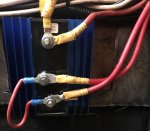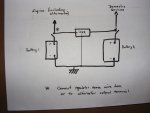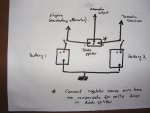youngkath
New member
Hi there folks,
Firstly, we have gained a huge amount of information from historic threads in this forum. So to all the regular posters, who have helped us fix our stern gland, fridge, water pump(s), countless engine leaks etc. etc. THANK YOU.
However... as always the boat jobs continue, and this is one (after 2 years extra experience) we just can’t fathom... whyyyy?!
To jump to the punchline, just checkout the photos below.
Or if you’re into the detail, here’s the story...(!) We had just launched the boat for the first time, cruised slowly from Preveza to Nydri. Fitted was a VSR combiner, with a Blamar regulator and alternator.
Then our batteries gassed... egg smell galore, the lot. We pulled into Nydri and a British electrician, offered to hook us up with a spare... 5min job - brilliant...
However... he also told us that our batteries were not isolated and advised we removed the combiner for a split diode. He was not a fan of “gadgets” or “ready glossy magazines” which we now think means, electrical technology beyond 1970. In our naivety we let him go ahead and paid him.
We’ve limped along ever since, thankfully with our solar and wind generator in the Aegean keeping us going. Amazingly, we’ve only just realised that we don’t think the house batteries are being charged at all by the alternator... only the start.
Before we start taking it apart, can anyone fathom whyyyyyyyy?! Are we missing something and do any electrical experts have advice on best solution for our setup:
340ah batteries
295 watt solar
Aero6gen
Huge thank you for reading and your comments in advance
Kath & T
Firstly, we have gained a huge amount of information from historic threads in this forum. So to all the regular posters, who have helped us fix our stern gland, fridge, water pump(s), countless engine leaks etc. etc. THANK YOU.
However... as always the boat jobs continue, and this is one (after 2 years extra experience) we just can’t fathom... whyyyy?!
To jump to the punchline, just checkout the photos below.
Or if you’re into the detail, here’s the story...(!) We had just launched the boat for the first time, cruised slowly from Preveza to Nydri. Fitted was a VSR combiner, with a Blamar regulator and alternator.
Then our batteries gassed... egg smell galore, the lot. We pulled into Nydri and a British electrician, offered to hook us up with a spare... 5min job - brilliant...
However... he also told us that our batteries were not isolated and advised we removed the combiner for a split diode. He was not a fan of “gadgets” or “ready glossy magazines” which we now think means, electrical technology beyond 1970. In our naivety we let him go ahead and paid him.
We’ve limped along ever since, thankfully with our solar and wind generator in the Aegean keeping us going. Amazingly, we’ve only just realised that we don’t think the house batteries are being charged at all by the alternator... only the start.
Before we start taking it apart, can anyone fathom whyyyyyyyy?! Are we missing something and do any electrical experts have advice on best solution for our setup:
340ah batteries
295 watt solar
Aero6gen
Huge thank you for reading and your comments in advance
Kath & T




